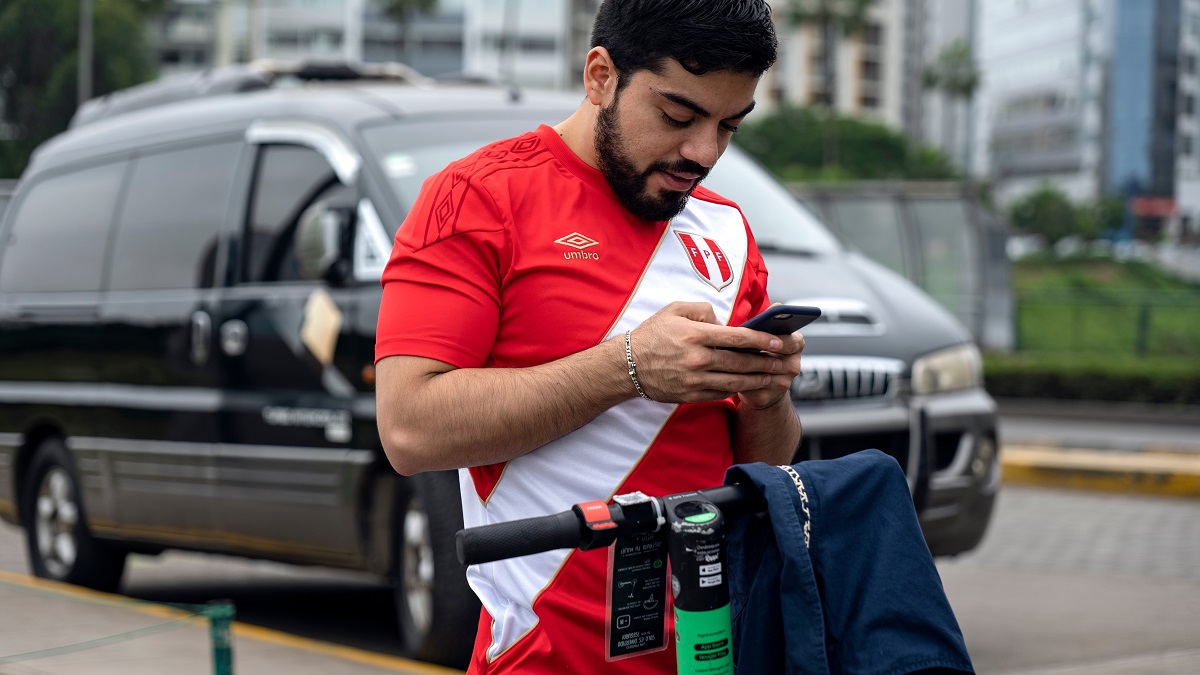The eTrade readiness assessment underway in Peru will help accelerate digital transformation and e-commerce development efforts.

© Shutterstock/Myriam B | A consumer uses his mobile phone to unlock a scooter sharing rental service in Lima, Peru.
UNCTAD’s ongoing eTrade readiness assessment for Peru – the first in Latin America and the Caribbean – will provide up-to-date diagnostics of how the country is taking advantage of the potential of digitalization and e-commerce for development.
It will also help the country mobilize support and strengthen public-private dialogue as well as inter-ministerial coordination for e-commerce.
“Digital transformation will undoubtedly offer opportunities for Peru to advance its economy. Given the cross-cutting nature of e-commerce, cooperation between development partners and beneficiary countries is critical for effective implementation,” UNCTAD Secretary-General Rebeca Grynspan said.
The Peruvian government is committed to boosting the digital economy, e-commerce, digital entrepreneurship and innovation, especially to benefit small and medium enterprises (SMEs), said Marushka Chocobar, Peru’s secretary of government and digital transformation.
“This assessment is particularly relevant to identify the needs of regional and local governments and drive the advancement of the digital economy in Peru,” Ms. Chocobar said.
The assessment is part of the UNCTAD-led eTrade for all initiative.
Multistakeholder approach
In preparation for the assessment, multistakeholder consultations took place from 4 to 6 October in the Peruvian capital of Lima to map opportunities, challenges and policy solutions.
Partners such as the United Nations Commission on International Trade Law (UNCITRAL) and the United Nations Economic Commission for Latin America and the Caribbean (ECLAC) joined the consultations as well as Pierangela Sierra, UNCTAD’s eTrade for Women Advocate for Latin America and the Caribbean.
The assessment is supported by Switzerland’s State Secretariat for Economic Affairs (SECO), a core donor of UNCTAD’s e-commerce and digital economy programme.
“The added value of such an assessment lies in the identification of technical assistance projects that can help the country harness opportunities offered by digitalization,” said Alain Brühlmann, head of economic cooperation and development at SECO Peru. “Therefore, we are willing to explore additional support consistent with the recommendations.”
Burgeoning e-commerce market
Partly fuelled by the COVID-19 pandemic, Peru is recording one of the highest growth rates in e-commerce in Latin America and the Caribbean. Online sales in the country amounted to $9.3 billion in 2021, a 35% increase from 2020, according to the Peruvian chamber of electronic commerce.
With digital payments growing, Peru’s e-commerce market is expected to reach $14 billion by the end of 2022, the United States international trade administration estimates.
Reducing digital gaps
While the country’s internet penetration rate reached 71% in 2021 according to the International Telecommunication Union, UNCTAD and its partners found that only 9% of rural Peruvian households had access to the internet.
The digital urban-rural divide affects online sales, with only roughly 10% of them coming from provinces other than Lima, according to the US international trade administration’s findings.
Policies to improve e-trade readiness
While Peru is yet to develop a national e-commerce strategy, government actors, businesses and international partners have focused on actions required under seven policy areas to improve e-trade readiness.
For ICT infrastructure and services, it’s crucial to adapt the regulatory framework and work with local governments to mobilize private investments to expand internet coverage in rural and remote areas.
For stronger legal and regulatory frameworks, it’s essential to involve all relevant stakeholders of the e-commerce ecosystem in design and reform processes.
Concerning e-commerce logistics, it’s necessary to improve road infrastructure, adapt airport capacity and provide more resources to help postal operators modernize their operations through digital transformation.
On trade facilitation, it’s important to continue implementing paperless cross-border trade procedures, besides adapting and streamlining customs IT systems.
To foster e-payment, there are efforts towards greater interoperability among different solutions, as well as incorporating new players and innovation solutions, which could potentially reduce transaction costs and increase financial inclusion.
To tackle a lack of digital skills, ramping up support for SME digital transformation will be critical to achieving greater scalability and digital entrepreneurship in interior Peru.
Such transformation could also improve access to finance for e-commerce SMEs. To achieve this objective, the country needs to hone a stronger innovation culture among local investors and better prepare ventures towards an acceleration stage.
To strengthen the e-commerce ecosystem, the country has created and within the framework of the eTrade readiness assessment a national technical committee for e-trade, comprising the most relevant national stakeholders, to enhance coordination.


